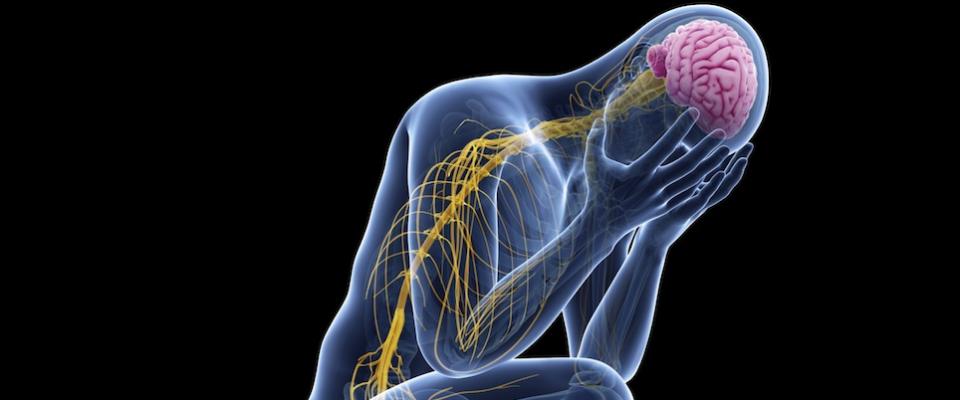Ah stress: It can be a blessing and a burden.
Its bursts can spur us to make decisions under pressure, giving us an energizing jolt as the body responds with quickened breath and the mind moves at a rapid-fire pace.But it can also be overwhelming—whether it results from caring for an elderly parent, working for an unsupportive boss, or straining to pay off crushing debt. That quickened breath instead turns into a shallow gasp, and the mind becomes a vice holding on to feelings of frustration and helplessness.
The “stress paradox” is evident in two recent and seemingly contradictory UC Berkeley studies: One determined that stress can be good for you, while the other concluded that it may lead to mental illness.
Yet scientists say both can be true.
Indeed, the same Cal researcher, Daniela Kaufer, actually worked on both studies.
The distinction between good and bad stress is a tipping point—the moment at which anxiety transforms from a motivating factor into a force that overpowers our resilience. Scientists know that a severe, prolonged bout of anxiety puts the body’s stress response system into a tailspin. It can even change the way the brain expresses certain genes.
For years Kaufer, an associate professor of integrative biology at U.C. Berkeley, has been trying to understand when and how stress becomes toxic to the brain and body. Her work gets at the complexity of the human instinct to fight or flee.
First, the upside. Last year, she published an eLife paper showing that rats exposed to a brief period of stress actually experienced new cell growth in their brains, which enhanced their memory. In other studies, the quick release of stress hormones through exercise and sex has also been linked to cell birth. No wonder stress can feel thrilling in the right situation—processes happening quietly in our body improve the mind’s power.
Then, the downside. This month, a study of Kaufer’s featured in Molecular Psychiatry offered a novel explanation for how relentless stress can actually change the brain’s structure and lead to mental illness. That study, which Kaufer said took seven years to complete because of an arduous review process and unforeseen logistical setbacks, attempted to answer a key question about the long-term consequences of chronic stress on the same set of cells. Is there a point, she and her colleagues wanted to know, when stress suppresses the growth of those cells?
“If you go and look at the literature, we know there is a correlation between stress and mental illness,” Kaufer said. “We don’t have much of a mechanism to explain why.”
Her study made a convincing argument. Kaufer and her colleagues immobilized adult mice repeatedly and analyzed what happened to their brains. They observed a long, complicated domino effect in which stress can override the function of cells designed to become neurons. Instead, they turn into cells that ultimately produce more white matter in the brain.
White matter, although essential to survival, has been seen in abundance in the brains of patients who experience schizophrenia, bipolar disorder and post-traumatic stress disorder. It is made up of neuronal fibers that are wrapped in insulation called myelin. This sheathing allows the brain to make faster, better connections—and some researchers, including Kaufer, hypothesize that excess myelin can strengthen the connection between parts of the brain that regulate fear and emotion, allowing stress signals to strike quickly and intensely.
That probably sounds familiar to anyone who has ever felt panic and fear when it might not be warranted. Take, for example, the combat veteran who associates loud explosions with the death of a comrade, and now can’t shake that visceral memory when he listens to a car backfire at home. But the experiences that trigger anxiety don’t have to be related to life or death. Perhaps it’s bumping into a co-worker that you’ve disliked for some time, whose presence reminds you of office conflict. Plenty of employees have spent an afternoon or longer in the throes of this kind of stress.
The problem is that we’re all moving through these experiences practically blind….Kaufer’s study may eventually contribute to the discovery of a biomarker that could alert doctors to those silent changes.
Kaufer is not alone in trying to understand where the line is drawn between healthy and destructive stress. She works with a handful of other Cal researchers who are exploring different angles of the same question. These faculty colleagues include neuroendocrinologists Lance J. Kriegsfeld and George E. Bentley, and neuroscientist Darlene Francis. At first glance, the collaboration between Kaufer and the others might not seem like a natural fit. Kriegsfeld and Bentley study how external factors such as stress impact biological rhythms and reproductive functioning. They’re not measuring mental illness per se, but they are interested in how disruptions to the body’s rhythms can lead to depression, anxiety and decreased sex drive.
“I’m basically the hormone-behavior and reproductive-axis expert,” Kriegsfeld said. “Combining that with [Kaufer’s] expertise in stress, we can look at how stress can lead to suppression of the reproduction system.”
In the studies that Kriegsfeld leads, stress is most often inflicted upon mice or hamsters in the form of jet lag. What he wants to do is disrupt the circadian clock, which triggers the release of hormones necessary for ovulation and pregnancy. If that clock is removed from the brain of a rodent, it can’t ovulate. When that clock is thrown off by jet lag simulated repetitively, according to a study Kriegsfeld published in 2010, it decreases cell production in the brains of hamsters and makes it impossible for them to learn a simple task.
Though Kriegsfeld has never personally studied what happens to reproduction under short-term duress, he said there might be some benefit. Yet, he’s confident that too much stress can wreak havoc. As the body becomes preoccupied by anxiety, it neglects things like digestion and reproduction, Kriegsfeld said. The chronic stress can then spiral into painful physical conditions like ulcers and a vanishing sex drive.
Darlene Francis, an associate professor at the School of Public Health, has observed a similar tipping point in her work on how stress, particularly in early development and childhood, changes behavior.
In a 2011 Neuroscience Behavioral Review article, Francis wrote about previous studies that showed some early life “stressors”—like briefly separating a rat pup from its mother—to be in fact be stimulating, helping the infant to develop a resilient response to fear and anxiety.
“These early findings serve as a reminder that the common, implicit assumption that stressful events early in life inevitably lead to poor outcomes or phenotypes is simply wrong,” wrote Francis and her co-author.
But in Kaufer’s Molecular Psychiatry paper, on which Francis was a co-author, a different kind of stress led to a radically different outcome.
Prior to Kaufer’s study, many scientists did not believe that neural stem cells could change their function in the way she showed. David Panchision, chief of the Developmental Neurobiology Program at National Institute of Mental Health, said Kaufer’s most recent finding is important because it demonstrates how stress affects cell birth in an unusual and unexpected way, linking it to a pathway in the brain associated with a risk of mental illness. (Kaufer received NIMH funding for this study and currently has a research grant, which Panchision oversees.)
Without stress, Panchision said, we couldn’t respond to threats to our lives—and livelihoods. “However, stress can overwhelm the brain and become toxic when it becomes too intense, constant or unlinked from an ability to control your environment and reduce that stress,” he said. That out-of-control anxiety can lead to both physical and mental illness, from heart disease to diabetes to depression.
The problem is that we’re all moving through these experiences practically blind. There is currently no way of knowing when we’ve gone overboard and the stress that plagues us starts causing long-term effects on the brain. Kaufer’s study, Panchision said, suggests a potential mechanism—and may eventually contribute to the discovery of a biomarker that could alert doctors to those silent changes. Perhaps we’d even be able to prevent or treat them.
For now, Kaufer and her colleagues remain entrenched in the work of understanding the brain’s basic circuitry—and what stress does to it.
“We are looking at the how exposure to adversity early in life, or during the critical times (like puberty) sets the brain on a trajectory towards resilience or vulnerability,” she wrote in an email.
That’s a question that we’d probably all like to answer.






















